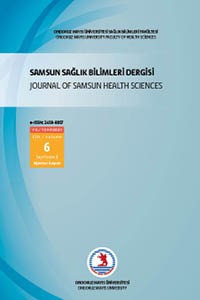Awareness Level of Nurses About Evidence-Based Practices: Peripheral Intravenous Catheter Applications
Öz
Aim: This study was conducted to emphasize the need for evidence-based nursing practice in peripheral venous catheter interventions and care, and to determine the level of awareness of nurses about evidence-based developments in peripheral intravenous catheter applications.
Method: The descriptive study was conducted in a university hospital, using the stratified sampling method, with nurses working in internal, surgical and intensive care units. The research data were collected using the "Nurse Introduction Form" containing the demographic characteristics of the nurses and the "Peripheral Intravenous Catheter Placement and Care Applications Form" prepared by the researchers using the relevant literature.
Results: 82.8% of the nurses participating in the study are women, 57.5% are single, 78.8% are undergraduate graduates, 17.2% are working in intensive care, 57.5% in internal clinics and 25.4% in surgical clinics. When the responses of the nurses to the suggestions in the Peripheral Intravenous Catheter Placement and Care Applications Form are examined; It was observed that they agreed with the statement “In case of any change or new discomfort in the catheter area, the patient should be encouraged to report this to the healthcare team” at the highest rate (99.3%). 40.3% of the nurses stated that they did not agree with the statement "If the patient does not have clinical signs of infection, gauze and opaque dressings should not be removed", 22.4% of them stated that they had no idea about the proposition "The infusions of only lipid solutions should be completed within 12 hours".
Conclusion and Suggestions: As a result of the study, it was found that the low rate of knowing about the evidences on the issues of dressing change, the duration of the catheter in the patient according to the treatment time and the catheter selection according to the properties of the fluids given to the patient intravenously.
Anahtar Kelimeler
Evidence-based practice Peripheral venous catheter Nursing care Evidence-based nursing
Kaynakça
- Abdelaziz, R.B., Hafsi, H., Hajji, H., Boudabous, H., Chehida, A.B., Mrabet, A. & Azzouz, H. (2017). Peripheral venous catheter complications in children: Predisposing factors in a multicenter prospect ve cohort study. BMC pediatrics,17(1), 208
- Alexandrou, E., Ray-Barruel, G., Carr, P.J., Frost, S., Inwood, S., Higgins, N., Lin, F., Alberto, L., Mermel, L. & Rickard, C.M., (2018). Use of short peripheral ıntravenous catheters: Characteristics, management, and outcomes worldwide. J Hosp Med, 22(30):1–7. Doi: https://doi.org/10.12788/jhm.3039.
- Atay, S., Şen, S., & Çukurlu, D. (2018). Phlebitis-related peripheral venous catheterization and the associated risk factors. Niger J Clin Pract, 21:827-831.
HEMŞİRELERİN KANIT TEMELLİ UYGULAMALARDAN HABERDARLIK DÜZEYİ: PERİFERİK İNTRAVENÖZ KATETER UYGULAMALARI
Öz
Amaç: Bu çalışma periferik venöz kateter girişimlerinde ve bakımında kanıta dayalı hemşirelik uygulamasının temellendirilmesi gerekliliğini vurgulamak ve periferik intravenöz kateter uygulamalarında kanıta dayalı gelişmelerden hemşirelerin haberdarlık düzeylerini belirlemek amacıyla yapılmıştır.
Yöntem: Tanımlayıcı kesitsel tipte olan çalışma, bir üniversite hastanesinde, tabakalı örneklem yöntemiyle dahili, cerrahi ve yoğun bakım birimlerinde çalışan mevcut hemşirelerle yapılmıştır. Araştırma verileri hemşirelerin demografik özelliklerini içeren “Hemşire Tanıtım Formu” ve araştırmacılar tarafından ilgili literatürden yararlanılarak hazırlanan “Periferik İntravenöz Kateter Yerleştirilmesi ve Bakım Uygulamaları Formu” kullanılarak toplanmıştır.
Bulgular: Araştırmaya katılan hemşirelerin %82.8’i kadın, %57.5’i bekar, % 78.8’i lisans mezunu, %17.2’ i yoğun bakımda, %57.5’i dahili kliniklerde, %25.4’ü cerrahi kliniklerde çalışmaktadır. Hemşirelerin Periferik İntravenöz Kateter Yerleştirilmesi ve Bakım Uygulamaları Formu’nda yer alan önermelere verdikleri yanıtlar incelendiğinde; “Kateter bölgesinde herhangi bir değişiklik ya da yeni bir rahatsızlık oluşması durumunda hastanın bu durumu sağlık ekibine bildirmesi için teşvik edilmelidir” önermesine en yüksek oranda (% 99.3) katıldıkları görülmüştür. “Hastanın klinik enfeksiyon belirtisi yoksa gazlı bez ve opak pansumanlar çıkarılmamalıdır” önermesine hemşirelerin %40.3’ü katılmadıklarını, %22.4’ü ise “Sadece lipidden oluşan solüsyonların infüzyonları 12 saat içinde tamamlanmalıdır” önermesine bir fikri olmadıklarını belirtmişlerdir.
Sonuç ve Önerileri: Araştırma sonucunda pansumanın değiştirilme durumları, tedavi süresine göre kateterin hastada kalma süreleri ve hastaya intravenöz yolla verilen sıvıların özelliklerine göre kateter seçimi konularına ilişkin kanıtlardan haberdar olma oranları düşük bulunmuştur.
Anahtar Kelimeler
Kanıta dayalı uygulama Periferik venöz kateter Hemşirelik bakımı Kanıta dayalı hemşirelik
Kaynakça
- Abdelaziz, R.B., Hafsi, H., Hajji, H., Boudabous, H., Chehida, A.B., Mrabet, A. & Azzouz, H. (2017). Peripheral venous catheter complications in children: Predisposing factors in a multicenter prospect ve cohort study. BMC pediatrics,17(1), 208
- Alexandrou, E., Ray-Barruel, G., Carr, P.J., Frost, S., Inwood, S., Higgins, N., Lin, F., Alberto, L., Mermel, L. & Rickard, C.M., (2018). Use of short peripheral ıntravenous catheters: Characteristics, management, and outcomes worldwide. J Hosp Med, 22(30):1–7. Doi: https://doi.org/10.12788/jhm.3039.
- Atay, S., Şen, S., & Çukurlu, D. (2018). Phlebitis-related peripheral venous catheterization and the associated risk factors. Niger J Clin Pract, 21:827-831.
Ayrıntılar
| Birincil Dil | Türkçe |
|---|---|
| Konular | Sağlık Kurumları Yönetimi |
| Bölüm | Orjinal Makaleler |
| Yazarlar | |
| Yayımlanma Tarihi | 31 Ağustos 2021 |
| Gönderilme Tarihi | 18 Mart 2021 |
| Yayımlandığı Sayı | Yıl 2021 Cilt: 6 Sayı: 2 |
Kaynak Göster
Cited By
Hemşirelik Öğrencilerinin Periferik Intravenöz Kateter Uygulamasına ilişkin Bilgi Düzeylerinin Belirlenmesi
Ege Üniversitesi Hemşirelik Fakültesi Dergisi
https://doi.org/10.53490/egehemsire.1172441
Hemşirelerin Periferik İntravenöz Kateter Uygulamasına İlişkin Bilgi Düzeyleri ve Uygulamaları
İzmir Katip Çelebi Üniversitesi Sağlık Bilimleri Fakültesi Dergisi
https://doi.org/10.61399/ikcusbfd.1308130
Samsun Sağlık Bilimleri Dergisi CC BY-NC 4.0 lisansına sahiptir.

